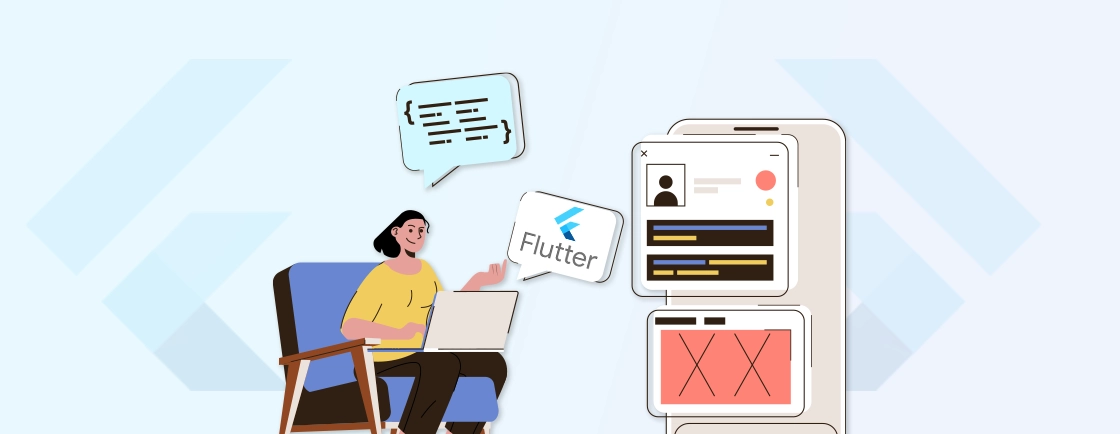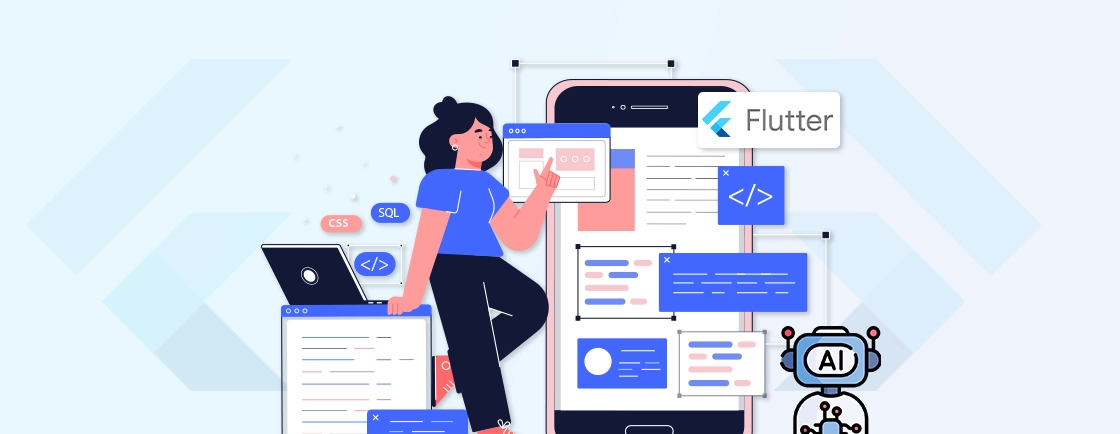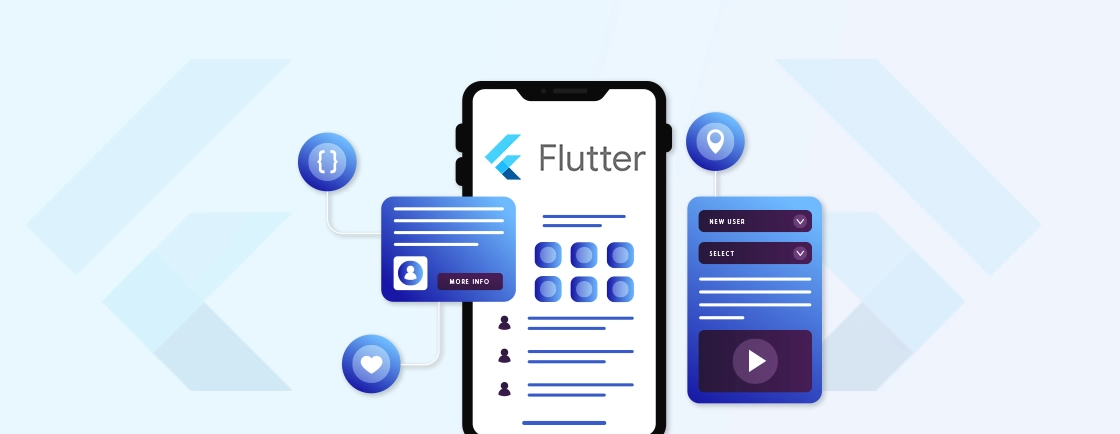Table of Contents
Imagine building a mobile app in hours—not weeks—with AI handling much of the heavy lifting. That’s what you get with the FlutterFlow AI. It streamlines the app creation by combining the power of no-code development with artificial intelligence.
FlutterFlow AI is designed to accelerate prototyping, automate UI design, and even suggest code optimization. Google’s Flutter framework ensures cross-platform compatibility, while AI enhancements reduce manual effort.
This blog will help you explore FlutterFlow AI and its key features. Plus, you’ll know how to build apps through this setup. Let’s begin.
What is FlutterFlow?
FlutterFlow is a visual no-code platform for cross-platform app development using Google’s Flutter framework. It lets developers drag and drop UI components, define logic with workflows, and connect to backend services. It’s all done through an intuitive interface.
Key Features of FlutterFlow
- Drag-and-Drop Builder: Create responsive UIs without coding.
- Real-Time Preview: See changes instantly on multiple device screens.
- Firebase & API Integration: Connect to databases, authentication, and third-party services.
- Custom Code Support: Extend functionality with Dart, Flutter’s programming language.
- One-click Deployment: Publish directly to the App Store, Google Play, or the web.
This tool was originally designed to speed up Flutter app development. But it has evolved into a powerful tool for startups, agencies, and enterprises looking to build apps faster. And the recent addition of AI has only made it that much better with code generation, design suggestions, and workflow automation.
What is FlutterFlow AI?
FlutterFlow AI is an intelligent assistant built into FlutterFlow’s no-code platform. It’s designed to accelerate and simplify app development using artificial intelligence. FlutterFlow AI can help users generate UI layouts, write custom code, troubleshoot errors, and even build entire app sections. All you need to do is describe what you need in natural language.
Key Capabilities
- AI-powered UI Generation: Create screens, widgets, and styles instantly with text prompts.
- Smart Code Assistance: Automatically generates Dart/Flutter code for custom functionality.
- Error Debugging: Explains issues and suggests fixes in plain language.
- Workflow Automation: Helps design app logic, API calls, and Firebase integrations faster.
- Instant Prototyping: Turns rough ideas into clickable prototypes in minutes.
With direct AI integration into the development process, FlutterFlow AI reduces manual work. All the while, it maintains Flutter’s performance and flexibility. If you don’t have deep coding expertise, but still need control over customization, FlutterFlow AI is suitable.
Key Features of FlutterFlow AI
With a foundation of Flutter architecture, the FlutterFlow AI platform can supercharge mobile app development. Plus the intelligent automation makes it faster and more accessible. Here are its standout features.
Sketch to Component
With FlutterFlow AI, you can turn hand-drawn wireframes into functional Flutter components instantly. All you need to do is simply upload a sketch, and FlutterFlow AI will convert it into clean, editable UI elements. It bridges the gap between paper prototypes and digital design.
Prompt to Component
Like sketches, all you need to do is describe what you need in plain english. Then, watch as FlutterFlow AI generates ready-to-use widgets, buttons, or forms. So you don’t even need any design skills, let alone coding skills. Just type what you envision and the AI builds it for you.
Prompt to Page
Need an entire app screen? Then type a description, and FlutterFlow AI constructs a fully-structured page. For example, an eCommerce product page with reviews and an add-to-cart button. It comes complete with responsive layouts and placeholder data.
Page Autocomplete
Stuck halfway through designing a screen? Let AI analyze your existing UI and suggest logical next steps. It can help whether you want to add missing elements, refine spacing, or optimize the component hierarchy.
Magic Cursor
Magic Cursor is an excellent feature of FlutterFlow AI. Click any widget, and FlutterFlow AI explains its properties and suggests improvements. It can even refactor it on demand. Think of it as an AI-powered inspector that helps you tweak designs faster.
AI Agent Builder
You can create custom AI agents that handle app-specific tasks without writing complex backend logic. Like, generating dynamic content, moderating user inputs, or personalizing recommendations.
Integrate with AI via API
You can connect your app to external AI models (like OpenAI or Gemini) directly through FlutterFlow’s visual API builder. Add chatbots, image recognition, or text analysis in minutes—no manual coding required.
Each of these features is designed to cut development time while keeping Flutter’s flexibility intact. All in all, FlutterFlow AI can help build the best mobile apps–smarter, not harder.
FlutterFlow is an easy-to-follow platform for app development. But hiring professional Flutter developers can make AI-aided development even more successful.
How to Build Mobile Apps With FlutterFlow AI?
FlutterFlow AI can blend no-code development with AI-powered automation. That’s how you build an app using its intelligent features.
Step 1: Sign Up & Create a New Project
Start by signing up for FlutterFlow and selecting “Create New Project”. Choose between a blank template or a pre-built starter app, then set your project name and target platforms (iOS, Android, or web).
Step 2: Design Your App Interface
Use FlutterFlow’s drag-and-drop editor to craft your UI. You can leverage AI-powered features like Prompt to Page and Sketch to Component to generate layouts instantly.
- Prompt to Page (generate entire screens from text)
- Sketch to Component (convert drawings into UI elements)
- Magic Cursor (get AI suggestions for widget improvements)
Customize fonts, colors, and widgets to match your brand—no design expertise required.
Step 3: Integrate AI Components Using FlutterFlow AI Gen
Enhance your app with AI using FlutterFlow AI Gen. Here’s what you can achieve.
- Using Prompt to Component for dynamic widgets
- Building an AI Agent for tasks like chatbots or content moderation
- Adding AI-generated code snippets for custom functionality
The AI handles the heavy lifting while you refine the logic.
Step 4: Add Backend Services
Connect Firebase (or a custom backend) for:
- User authentication
- Database (Firestore, Supabase)
- File storage (Cloud Storage)
- Real-time updates
FlutterFlow’s visual tools simplify backend setup, letting you focus on functionality rather than configuration.
Step 5: Integrate the Necessary APIs
Extend functionality by linking third-party APIs:
- Payment gateways (Stripe, PayPal)
- AI models (OpenAI, Gemini)
- Maps, SMS, or analytics services
FlutterFlow’s built-in API connector makes it easy to fetch and process external data without writing complex code.
Step 6: Test & Debug the App
Last but not least, preview your app in real-time across different devices. You can use FlutterFlow AI’s Magic Cursor to identify and fix issues. Once polished, deploy directly to the App Store, Google Play, or web with a single click.
With FlutterFlow AI, building a fully functional app is faster than ever. And what could be better is getting help from a dedicated Flutter app development company.
Let’s Summarize
FlutterFlow AI is an excellent advancement in developing apps faster, smarter, and more accessible. With the combination of no-code simplicity and AI-powered automation, you can bring ideas to life without getting bogged down in repetitive coding tasks.
Through FlutterFlow AI, you can build a quick prototype, a full-fledged production app, and more. The result? Less time spent on setup, more time refining what matters—your app’s functionality and user experience.
So ready to build your mobile app with FlutterFlow AI? Then hire Flutter App Developers to make things easier.
FAQs on FlutterFlow AI
Do I need coding experience to use FlutterFlow AI?
No! FlutterFlow AI is designed for both non-technical users and developers. It offers a visual builder and AI-powered tools. So you can create apps through intuitive prompts and drag-and-drop components. But coding could help with advanced customizations.
Is FlutterFlow AI suitable for production-ready apps?
Absolutely. Apps built with FlutterFlow AI compile to native code (via Flutter), ensuring high performance. Many startups and businesses use it to launch apps on the App Store, Google Play, and web.
How does FlutterFlow AI handle backend services?
You can connect Firebase for authentication, databases, and storage, or use REST APIs for custom backends. FlutterFlow AI simplifies backend setup with pre-built templates and visual workflows.
Can I add custom code to apps built with FlutterFlow AI?
Yes. While FlutterFlow AI automates much of the development, you can still extend functionality using Dart/Flutter code for more complex features or integrations.
Accelerate Development with Flutter
Build high-performance mobile, web, and desktop experiences from one unified Flutter codebase.





